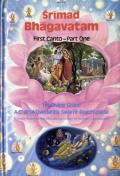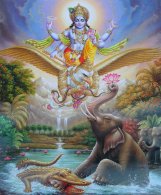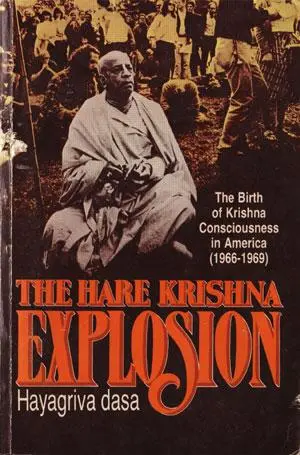I worship Govinda, the primeval Lord, who is adept in playing on His flute, with blooming eyes like lotus petals with head decked with peacock’s feather, with the figure of beauty tinged with the hue of blue clouds, and His unique loveliness charming millions of Cupids.
The following is a nice description of Govinda: verse and purport from Srila Prabhupada’s Brahma-samhita, and a short excerpt from a lecture on the Srimad Bhagavatam.
Śrī brahma-saṁhitā 5.30
veṇuṁ kvaṇantam aravinda-dalāyatākṣam-
barhāvataṁsam asitāmbuda-sundarāṅgam
kandarpa-koṭi-kamanīya-viśeṣa-śobhaṁ
govindam ādi-puruṣaṁ tam ahaṁ bhajāmi
SYNONYMS
veṇum — the flute; kvaṇantam — playing; aravinda–dala — (like) lotus petals; āyata — blooming; akṣam — whose eyes; barha — a peacock’s feather; avataṁsam — whose ornament on the head; asita–ambuda — (tinged with the hue of) blue clouds; sundara — beautiful; aṅgam — whose figure; kandarpa — of Cupids; koṭi — millions; kamanīya — charming; viśeṣa — unique; śobham — whose loveliness; govindam — Govinda; ādi–puruṣam — the original person; tam — Him; aham — I; bhajāmi — worship.
TRANSLATION
I worship Govinda, the primeval Lord, who is adept in playing on His flute, with blooming eyes like lotus petals with head decked with peacock’s feather, with the figure of beauty tinged with the hue of blue clouds, and His unique loveliness charming millions of Cupids.
PURPORT
The matchless beauty of Kṛṣṇa, the Supreme Lord of Goloka, is being described. Kṛṣṇa, the all-pervading cognition, has a spiritual form of His own. The form of Kṛṣṇa is not a fanciful creation of imagination formed after visualizing the beautiful things of the world. What Brahmā saw in his ecstatic trance of pure devotion, is being described. Kṛṣṇa is engaged in playing upon His flute. That flute by his enchanting musical sound attracts the hearts of all living beings. Just as a lotus petal produces a pleasant sight, so the two beautiful eyes of Kṛṣṇa who causes the manifestation of our spiritual vision, display the unlimited splendor and beauty of His moonlike face. The loveliness that adorns His head with peacock feather figures, the corresponding feature of the spiritual beauty of Kṛṣṇa. Just as a mass of blue clouds offers a specifically soothing, pleasant view, the complexion of Kṛṣṇa is analogously tinged with a spiritual dark-blue color. The beauty and loveliness of Kṛṣṇa is far more enchanting that that of Cupid multiplied a millionfold.

Here is Kṛṣṇa, Here is God
Śrīmad Bhāgavatam Lecture:
…So our Kṛṣṇa consciousness movement is so nice.. We present, “Here is God.” Here is God. Take His name. Take His address also. It is so perfect. They are searching after God. We are giving the name, address, activity, everything, quality, all. Nāma-rūpa-līlā-parikara-vaiśiṣṭhyam, everything. Nāma means name. Here is Kṛṣṇa, “He is engaged in enjoyment with Rādhārāṇī and playing on His flute.” Veṇuṁ kvaṇantam aravinda-dalāyatākṣaṁ bar… [Bs. 5.30]. We are not imagining. Not that this artist imagines, the poet imagines. No. We don’t do that rascaldom. We don’t do that. We take information from the Vedas. Kṛṣṇa, when He was present personally, He played on His flute. The gopīs saw and the cowherds boys saw five thousand years ago. And the ācāryas took information. Even if you don’t believe in the history, then come to śāstra. The śāstra says veṇuṁ kvaṇantam aravinda-dalāyatākṣam: [Bs. 5.30] “Kṛṣṇa, the Supreme Personality of Godhead, is always engaged in playing on His flute.” This is Vedic statement. Veṇuṁ kvaṇantam aravinda-dalāyatākṣam: [Bs. 5.30] “His eyes are just like lotus petals.” Veṇuṁ kvaṇantam aravinda-dalāyatākṣaṁ barhāvataṁsam asitāmbuda-sundarāṅgam: [Bs. 5.30] “He has got a peacock feather on His head.” These are the description in the Vedas. “He has got a peacock feather on His head.” Barhāvataṁsam asitāmbuda: “His color is blackish.” What kind of blackish? Asitāmbuda: “Just like new cloud.” Asitāmbuda-sundarāṅgam: “But don’t think because He is blackish, He is not beautiful. He is most beautiful.” How much beautiful? Kandarpa-koṭi-kamanīya-viśeṣa-śobham: [Bs. 5.30] “He is so beautiful that if you gather millions of Cupids, still He is more beautiful.” These descriptions are there.
So Kṛṣṇa consciousness movement is very nice. You will be able to understand what is God, and you will be able to understand what is your relationship with God. And you will be able to understand how you can go back to home, back to Godhead.
Veṇuṁ kvaṇantam aravinda-dalāyatākṣam [Bs. 5.30]. Don’t think that Kṛṣṇa figure is the imagination of some artist or painter. No, no. These are the description in the Vedas. Veṇuṁ kvaṇantam, the Supreme Personality of Godhead, Govinda, is playing on His flute. Veṇuṁ kvaṇantam aravinda-dalāyatākṣam [Bs. 5.30]. And His eyes are like the petals of lotus flower. Veṇuṁ kvaṇantam aravinda-dalāyatākṣaṁ barhāvataṁsam. There is a feather of peacock, asitāmbuda-sundarāṅgam, His complexion is like black cloud but very, very beautiful. Veṇuṁ kvaṇantam aravinda-dalāyatākṣaṁ barhāvataṁsam asitāmbuda-sundarāṅgam, kandarpa-koṭi-kamanīya. He is so beautiful that more attractive than many, many hundreds and thousands of Cupid. Kandarpa-koṭi-kamanīya-viśeṣa-śobhaṁ govindam ādi-puruṣaṁ tam aham bhajāmi [Bs. 5.30]. This is the Govinda’s description. There are so many descriptions.
So this is spiritual varieties. Material varieties cannot give us full satisfaction. Therefore you want change. Change, another change, another change. Punaḥ punaś carvita-carvaṇānām [SB 7.5.30]. Here in the material world we are simply chewing the chewed. Once chewed and thrown it away, again somebody is coming chewing. So spiritual variety is not like that. Spiritual varieties is ānandāmbudhi-vardhanam. The more you are attached to spiritual variety, it is just like ocean. An ocean does not increase, but spiritual varieties are said they are increasing. Now just like here you have got the Arabian Sea. It is not increasing. It would have increased, then Bombay town would have been finished long ago. So it is not increasing. It has got a certain limit. You go to the beach you see no, no more than. But it is compared with ānandāmbudhi, the ocean of bliss, increasing, vardhanam. Ānandāmbudhi-vardhanam. The more you enter into the spiritual bliss, the more you become joyful. That is spiritual. Spiritual, just like these boys, these girls they are chanting Hare Kṛṣṇa. Had it been hackneyed, how long they would have chanted? No. That is not possible. Unless it is spiritual, nobody can be satisfied simply by chanting Hare Kṛṣṇa Hare Kṛṣṇa. You take any other word, “Mr. John, Mr. John, Mr. John,” how long you will chant? After chanting for half an hour you will be fed up. But this is ānandāmbudhi-vardhanam. The more you chant the more you become spiritually advanced. This is called ānandāmbudhi-vardhanam. Otherwise how one can be satisfied simply by chanting, chanting Hare Kṛṣṇa? They are not mad, they are not foolish. They are human being. And how they have given up everything simply by chanting if it is not ānandāmbudhi-vardhanam, if it is not increasing in spiritual blissfulness. Practical. They have forgotten everything, they are also young men. They don’t go to cinema. Just one block after there is cinema, they will never go, giving up this chanting and go to the cinema. Don’t you see practically?
But our philosophy is different. Our philosophy is that as there are varieties in this material world, there are varieties in the spiritual world. That varieties. Just like the sky. In the sky, there are varieties. There are different kinds of planets, floating in the sky. Ordinarily seeing, in daytime, we see the sky is vacant. How it is vacant? It is not vacant. It is the defect of my eyes that I cannot see the varieties. The vari… At night we can see the varieties. There are so many planets, so many stars. And each of them full of varieties. Just like this planet. It is, we learn from the śāstra. Yasya prabhā prabhavato jagad-aṇḍa-koṭi-koṭiṣv aśeṣa-vasudādhi bhinnam [Bs. 5.40]. There are innumerable universes. This universe is one only. And each and every universe, there are millions of planets. And each of them has got special significance. Just like this Moon planet, the Sun planet, this Earth planet, each one has got significance. Here, the bodies are earthly. In the Sun planet, the bodies are fire. Fiery. Similarly in the Moon planet, the bodies are different. Each and every planet.
Thank you very much. (end)














